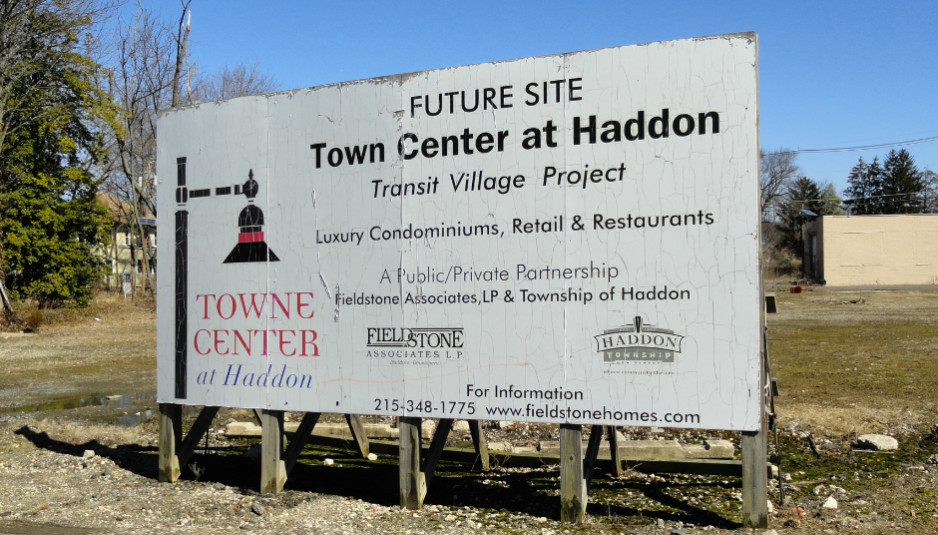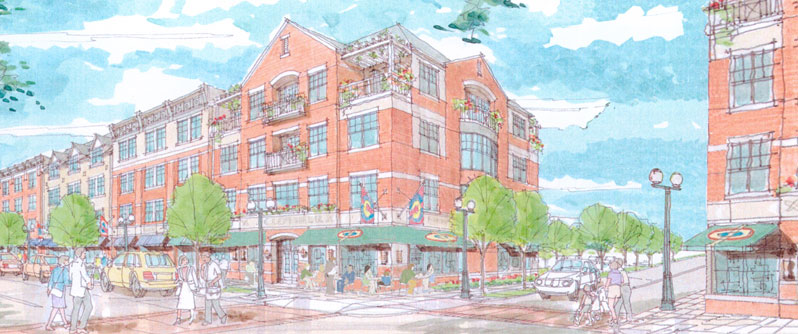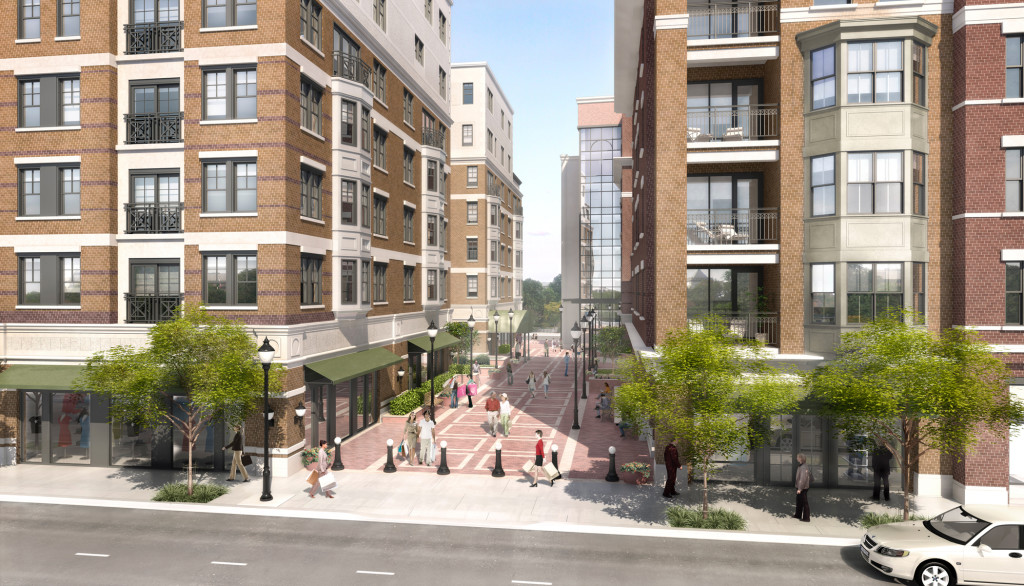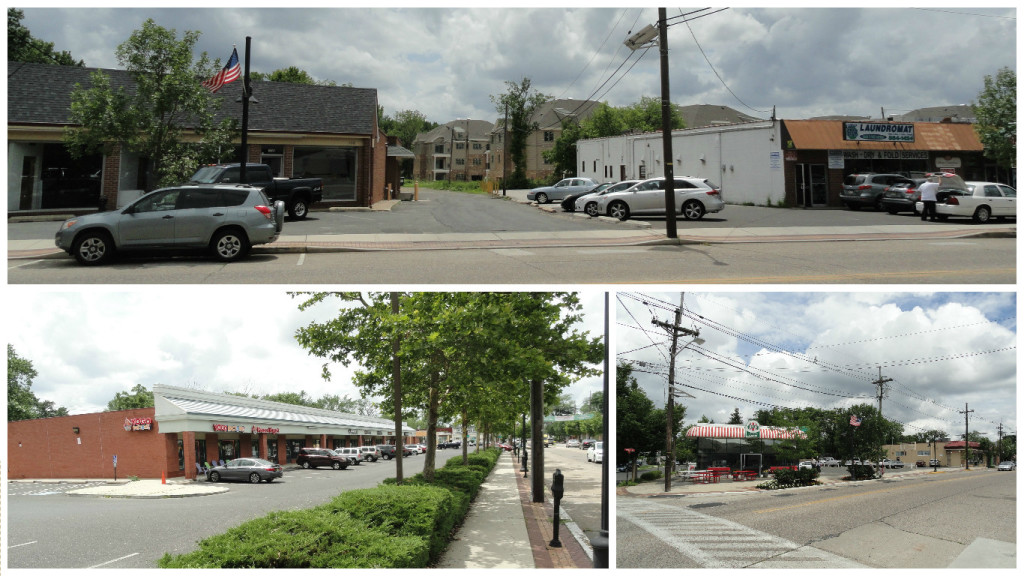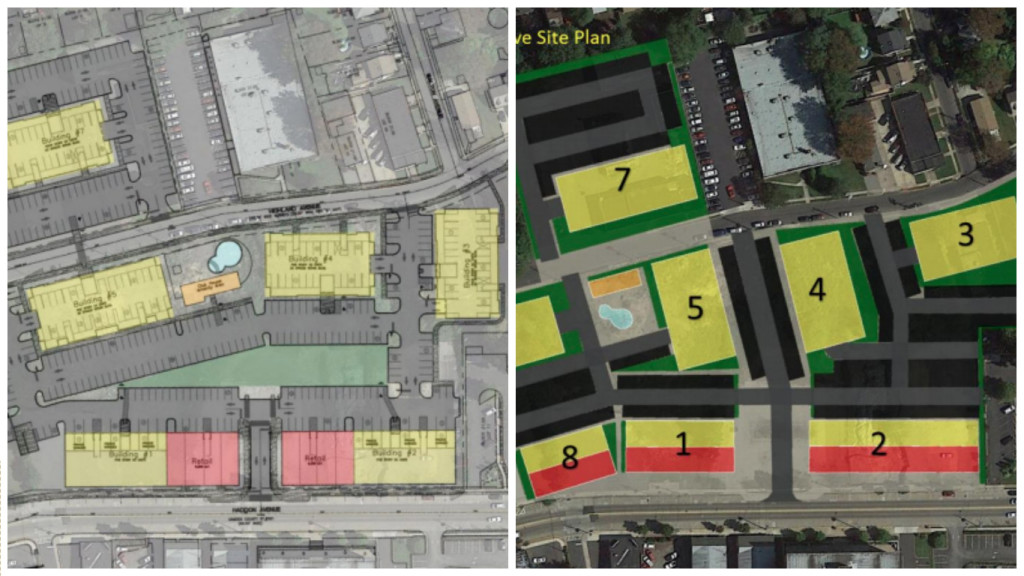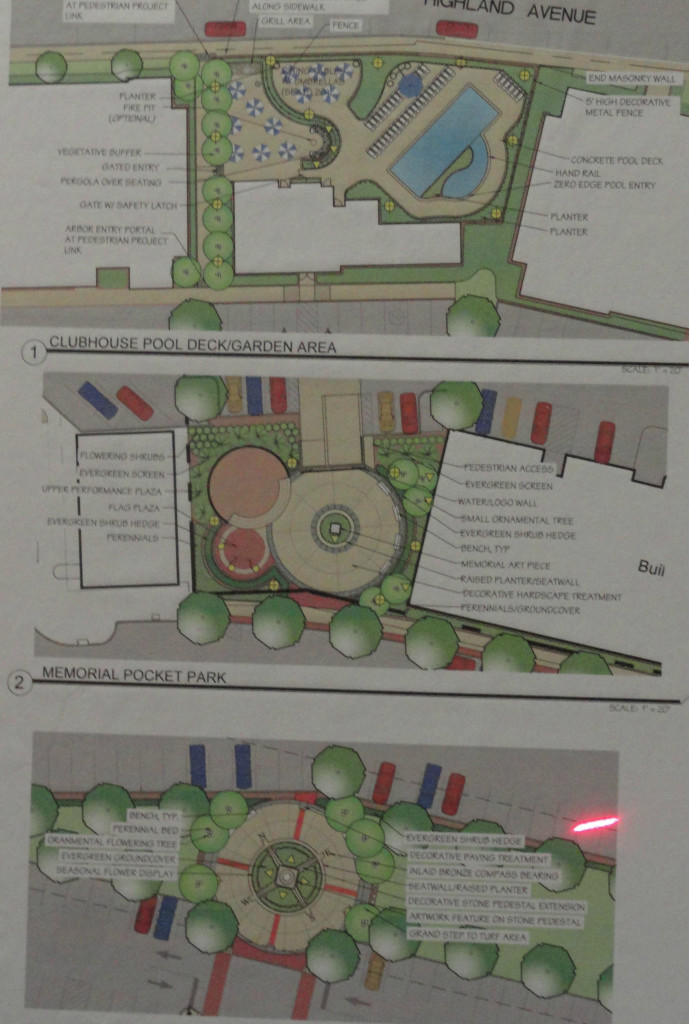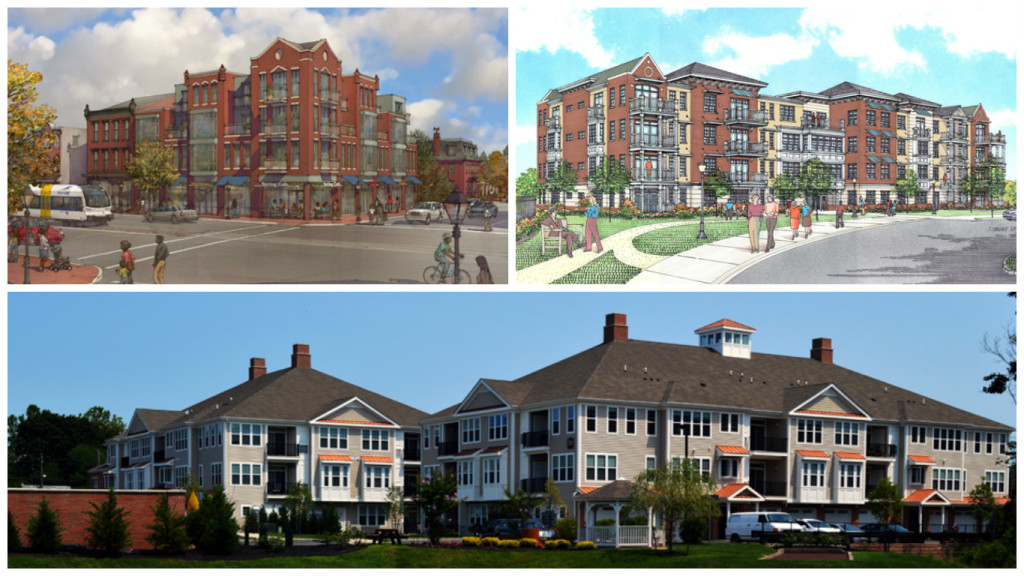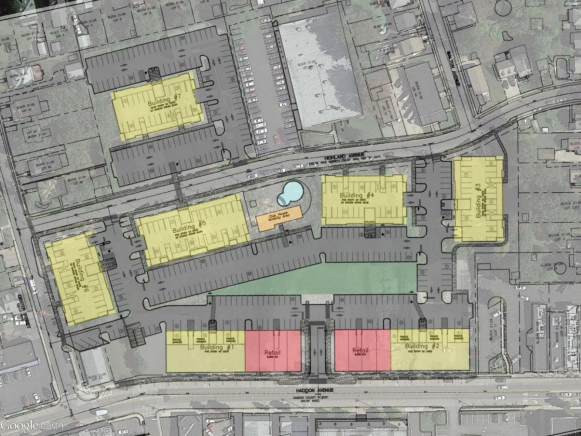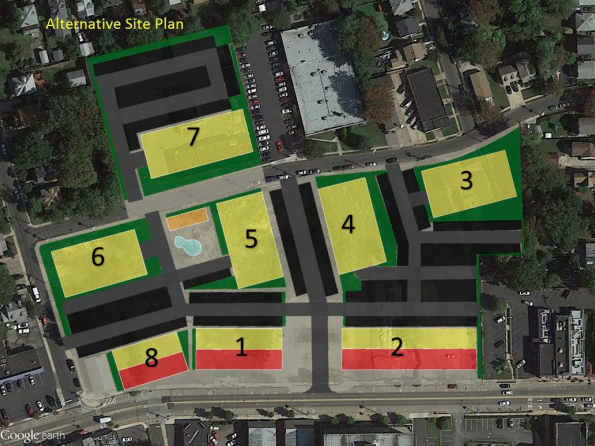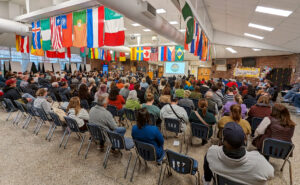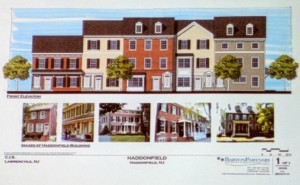Members of the South Jersey Urbanists planning and design group offer an open letter to the Haddon Township Planning and Zoning Board on the Dy-Dee redevelopment site.
This letter was written by members of the South Jersey Urbanists group about the Dy-Dee redevelopment site, also known as the Haddon Towne Center project. It was sent to members of the Haddon Township Planning and Zoning Board, and contains formalized recommendations to the board about key elements of the site plan proposed by developers Fieldstone Associates October 1. It is reprinted here in the interests of continuing a public conversation about the project in advance of an October 19 special meeting of the board.
Want to weigh in with your take on the Dy-Dee/Haddon Town Center redevelopment plans? Click here to take the NJ Pen public interest survey, and add your perspective to data that will be presented to the Haddon Township Planning and Zoning Board before the meeting.
For archived coverage of the redevelopment project, click here—ed.
An Open Letter to the Haddon Township Planning and Zoning Board
re: the Dy-Dee Redevelopment Site/Haddon Towne Center Project
We believe that the developer, the Haddon Township Planning and Zoning Board, and representatives of the community at large can work congenially and collaboratively to improve the proposed site plan.
The satisfactory review of this project by the board and the opportunity for meaningful public comment is guaranteed by the settlement agreement ratified by the Haddon Township Commissioners. That agreement protects and assures that the public has a real opportunity to inform the process of development in Haddon Township.
With a few slight—but meaningful—design changes, the township can be invested in a facility that connects its residents with a welcoming sense of place, instead of being saddled with an suburban-style building complex that is segregated from its neighbors.
Enacting these changes would still allow the parties to meet every requirement of the negotiated settlement among the township, Fair Share Housing, and Fieldstone Associates. It creates a development that supports the same number of apartments, parking spaces, and adequate parking ratio (1.7 spaces per unit) as in the original design, without changing the general floorplan or number of floors in each building.
While preserving the key terms of that agreement, we estimate these changes could allow the developer to gain an additional four market-rate units. The changes could add 4,000 square-feet of commercial space along Haddon Avenue, or use this bonus space to relocate the apartment amenities. Additionally, the changes would improve the stature of the site while yielding greater profitability for the effort.
The board has both the authority and the obligation to review aspects of the site plan beyond its objective, measurable features and conformation to ordinance. It is a body that is a custodian of the community; a collection of neighbors entrusted with its stewardship. It has the opportunity to set a course for that community by helping to create a strong, meaningful, and functional public space that will resonate with future generations.
On the 150th anniversary of this township, a momentous opportunity is presented here to shape its next 150 years. This is a win-win opportunity, and it’s not too late to take it. Please give your full consideration to the following recommendations, and help us coordinate work with the developers to make this the best town center possible.
UNDERSTANDING
The Haddon Township Master Plan and Redevelopment Plan reflects intrinsic ideas about development standards in downtown or “Main Street” areas:
- They must be densely developed with a mix of uses that provides a variety of activities that engage the public.
- They should be well connected to the adjacent neighborhoods. Those connections should be scaled to the pedestrian experience, and not engineered for the speed and convenience of automobiles.
We believe the following aspects of the design presented by Fieldstone Associates fail to meet the standards required of the Haddon Township master plan, redevelopment plan, and municipal codes:
- There are ground-level residential units facing Haddon Avenue (Buildings #1 and #2), degrading the public domain with dull or inappropriate uses that front streets and sidewalks.
- Buildings (#3 and #7) face no road at all, degrading the public domain with dull or inappropriate uses that front streets and sidewalks. These buildings conform to suburban design standards, not those of a mixed-use, transit-oriented development.
- The façade is of low quality. Its design also is more in the styling of a rural apartment building (quite similar to another of architect Victor Barr’s design: the Marlton Gateway Apartments.) It lacks visual interest, and is not harmonious with neighboring buildings. Neither are its design elements appropriate for a Main Street, town center development.
- The recreational and open spaces in this design are not oriented in a functional position for public accessibility. There are no architectural or public-space features that define this site as a Town Center. In rural or suburban apartment developments, a clubhouse element is typically inserted to manufacture a public gathering space. In Haddon Township’s urban environment there is already a top-rate public pool, and many social gathering places in the form of bars and cafes, with the opportunity for more onsite.
We believe the developer could offset the costs of the suggested changes below by eliminating the costs of constructing and maintaining the pool and clubhouse elements, adding additional market-rate units, increasing the value of the proposed retail units through better design, and potentially obtaining grants by designating the area a “transit village.”
RECOMMENDATIONS
To achieve the “Main Street” characteristics prescribed by the Township’s planning documents while meeting the agreed-upon design standards for this site, we strongly recommend the following alterations to the proposed site plan.
- Create a central road (“Town Center Boulevard”). Adding a central access road connecting Haddon Avenue directly to the opening of the Highland Avenue parking lot would do a few important things for the site.
- It would incorporate the existing neighborhood road network into the development, rather than isolating it, easing what Fieldstone traffic expert David Shropshire called “a natural flow” during rush -hour/school-hours.
- It would split the large block (bordered by Highland, Haddon, Center, and Crystal Lake Avenues) into two smaller blocks to allow alternative travel routes for cars and pedestrians, improving the flow of traffic to, from, and within the site. The latest design from Fieldstone forces pedestrians to choose from walking through a large and unsafe parking lot, or traveling around the site entirely. A central boulevard would provide a safe and interesting pathway through the site.
- It would open up a sight line from the existing office building in the rear of the development on Highland Avenue to the front of the development on Haddon Avenue. This alignment creates the illusion that the existing office building is actually part of the new development, and incorporates it more fluidly into the activity of the town center. Employees and visitors to the office building would pass by the new commercial spaces on their along their way, increasing stature and foot traffic of those spaces. Furthermore, should the owners of the office building decide to sell or redevelop it in the future, it could be seamlessly incorporated into the town center.
- The existing parking lot on Highland Avenue would become a shared parking asset, either officially, or by circumstance. The lot is mostly used only a few nights a week, and overflows with parking demand on those nights. With the new alignment, customers would have access to additional public parking along the central boulevard. When the lot is not in demand, it serves as additional parking for residents and customers of Haddon Ave businesses.
- Lining the central boulevard with 10-foot sidewalks and tall apartment buildings helps continue the feel of a main street development into the site, rather than confining its Main Street characteristics to Haddon Avenue.
- This design revision transforms the retail spaces at the gateways of the central boulevard into higher-value corner-unit properties that are more desirable and have the ability to attract stronger rents and a better brand of business.
- Parking in the area would become more intuitive: the central boulevard would be situated perpendicular to Haddon Avenue, connecting it to Highland Avenue, which also provides loops back to Haddon Avenue on Center Avenue and Crystal Lake Avenue.
- We also suggest that the ground-floor apartment units facing this central boulevard incorporate structural designs that would allow them to be converted to retail at a later date, should the demand arise. Exercising this future option gives the town center added potential to draw additional business to the community as a destination shopping location not unlike the Gloucester Premium Outlets or the Promenade in Marlton.
- Allow only retail uses to front Haddon Avenue. This is a significant change to the proposed site plan. The primary advantage of this change is the removal of an unnecessary blight designed into the developer’s proposed site plan.
- Residential units on the ground level of Haddon Avenue put private living space directly in view of the public. Residents of those units would naturally try to delineate their private space from the public by permanently drawing their blinds. Thus, an uninviting streetscape experience becomes even less inviting, deterring walking traffic from the area and adjoining business units. Eliminating this situation is paramount.
- The streetscape experience would be vastly improved with additional lengths of commercial space. More windows into retail spaces would encourage more window shopping, causing pedestrians to linger and enjoy the town center. Social activity begets more activity, and pedestrians and shoppers themselves become an asset to the area.
- The existing downtown, “Main Street” development pattern would be uninterrupted by unexpected and out-of-context use if commercial or community space is required for all frontage on Haddon Avenue.
- Align Buildings #3 and #7 to face Highland Avenue, place all parking behind Building #7, and rotate other buildings to front on the suggested central boulevard.
- Removing vast parking lots from the sidewalk experience improves pedestrian safety and overall aesthetics. Shifting the buildings in this way also allows subtle changes that increase the overall usability of the site. (see below for illustration)
- This improvement would keep headlights, noise, and traffic out of view of neighboring homes and apartment buildings; residents in the surrounding neighborhood will enjoy front views of tree-lined streets with residential architecture, not busy parking lots.
- The change in building layout allows the parking lot entrance from Center Street to accommodate two-way traffic, improving the flow of parking traffic in and out of the site.
- Placing Building #7 along Highland Avenue and consolidating its parking into one contiguous lot behind the building is a more efficient use of space. It allows for larger green spaces in the front of the building and along the back of the lot. A wider strip along the back of the lot accommodates larger trees that can help obscure views into the backyards of Virginia Avenue residents; setting the building forward a greater distance from Virginia Avenue also lowers the effective elevation from their perspective.
-
Relocate public-space amenities to the center of the site.
- The shifting of the buildings and creating the central boulevard allows the proposed pocket park to be placed in the center of the site in the form of a hardscaped plaza or piazza.
- A plaza situated in the middle of the town center creates a natural gathering place for residents and the public. Ample room is available for businesses to provide space for outdoor café seating, beer gardens, community events, and live entertainment—the kinds of amenities that attract the high-rent-paying tenants the developer is seeking.
- Inclusion of shaded seating and greenery would further encourage pedestrians to linger near the commercial spaces and shop.
- Closing off the front section of the central boulevard from thru-traffic could create a large event space suitable for street events and festivals. The distance between Buildings #1 and #2 would be approximately 100 feet (see below), which affords an area double that allotted the Westmont Farmers Market on Stratford Avenue. This creates the possibility of programing several events as a regular feature of town center, and is possible because of the suggested improvements to traffic flow mentioned above.
- Improve the overall façade of the buildings.
- This change is more of a requirement to meet the minimum design standards of the township, redevelopment area, and developer’s agreement. The architecture must be an appropriate part of the main street business corridor. As currently proposed, the architecture does not harmonize with the neighboring buildings, nor does it create an architectural cornerstone to the town, which is the intent of a town center.
- Along with the centralized plaza, an improved façade would open up a landmark to views as far down Haddon Avenue as the Westmont Theatre. Building #2 would become a visual terminus that would naturally draw interest from passers-by, and would attract visitors simply by creating a clearly important central place.
- The original architectural drawings agreed to by the township planning board were vastly superior to those in the recently proposed plan. Such a drastic change in design abandons any acceptance the development concept had accrued from the township planning board and the public, and the architectural design must return to such standards in order to regain acceptance.
- Lower the parking lots under each building to below (or partially below) grade.
- This change would further improve the streetscape experience of each road with a residential building fronting it. Keeping the storage of private property (cars) out of the public domain is an aesthetic improvement that cannot be understated.
- Lowering the parking lowers the height of each building entirely, lessening the overbearing presence that large, multi-unit structures impose on residents in the surrounding neighborhoods.
ILLUSTRATIONS
The image below illustrates how every improvement listed above could be incorporated into the design of the Town Center. It does NOT represent a professional engineering site plan or any exact dimensions. It is only a rough, graphic representation that demonstrates how the site is capable of accommodating these design improvements.
Once again, every building is the same number of floors and the same dimensions. The few exceptions are:
- Building #1 (originally 225’ wide) becomes two buildings of 115’ and 145’ widths.
- Building #5 (originally 180’) is shortened to 145’, and Building #7 (originally 145’) is widened to 180’.
- Additionally, a space was allocated for a clubhouse and pool, but we believe this could be eliminated or relocated to offset commercial space along Haddon Avenue, allowing for additional parking or permeable greenspace in its place.
Want to co-sign this letter? Send an e-mail to the Haddon Township Commissioners and Planning and Zoning Board Secretary Bonnie Richards:
mayorteague@haddontwp.com
pdougherty@haddontwp.com
jfoley@haddontwp.com
brichards@haddontwp.com
Get more local news that matters. Check out NJ Pen on Facebook and Twitter, [tinypass_offer text=”or click here to become a supporter.”]

